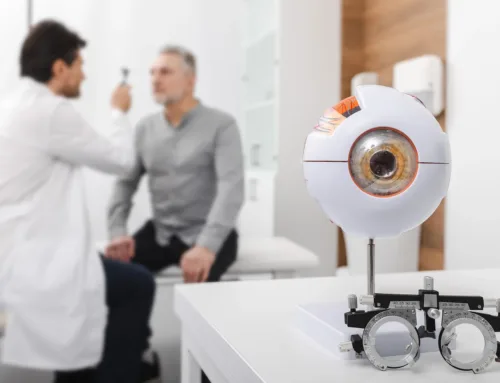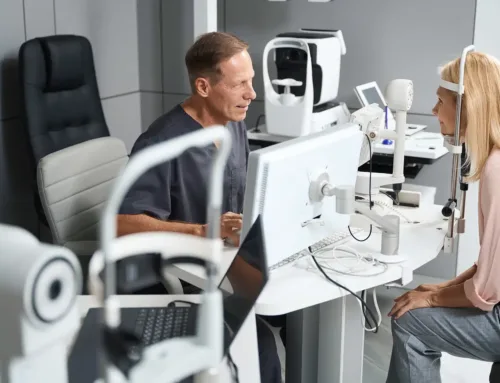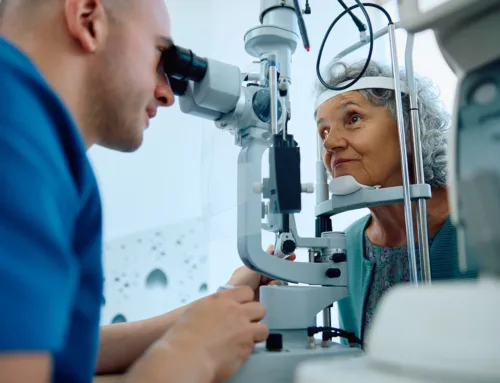Cataracts, a clouding of the eye’s natural lens, can significantly impair vision over time. A common concern among those developing cataracts is if cataract surgery can correct vision effectively? The short answer is yes, but there are nuances to consider, which is what this blog will explore. We’ll take a look at the intricacies of cataracts, the surgical process, potential vision outcomes, and the various artificial lens options (IOLs) available to patients. So, let’s dive in and discover how cataract surgery can correct vision and restore clarity.
Understanding Cataracts – Causes & Symptoms
Cataracts form due to the natural breakdown and clumping of proteins in the eye’s lens as we age. This is what causes the lens to become cloudy or opaque, obstructing light from properly focusing on the retina and leading to blurred or hazy vision. While cataracts are often age-related, other factors can contribute to their development:
- Genetics: A family history of cataracts can increase your risk.
- Diabetes: This condition can lead to earlier development of cataracts.
- Trauma: Eye injuries can cause cataracts to form.
- Medications: Long-term use of corticosteroids may contribute to cataract development.
The primary symptom of cataracts is a gradual blurring of vision, often described as looking through a foggy or dusty windshield. Colors may appear muted, and night vision can become particularly challenging. Given these symptoms, this is why many wonder if cataract surgery can correct vision and restore clarity, effectively.
What Is Cataract Surgery & Why It’s Done?
Cataract surgery is a procedure designed to remove the cloudy lens and replace it with an artificial intraocular lens (IOL), restoring clear vision. It’s recommended to patients when cataracts begin to interfere with daily activities such as reading, driving, or recognizing faces.
Will Cataract Surgery Give Me 20/20 Vision? Factors & Considerations
While achieving 20/20 vision after cataract surgery is possible, it’s not guaranteed. Several factors influence whether cataract surgery can correct vision to 20/20 levels, including the type of IOL used, the presence of pre-existing eye conditions like glaucoma or macular degeneration, and surgical technique employed. However, most patients experience a substantial improvement in vision, often eliminating the need for glasses for distance vision.
Cataract Surgery Options – Tailored To Your Needs
Cataract surgery techniques have evolved, offering patients several options to suit their needs and preferences.
Basic Cataract Surgery – Highly Effective & Widely Used.
The traditional method, known as phacoemulsification, involves using ultrasound waves to break up the cloudy lens, which is then removed and replaced with an IOL.
Laser Cataract Surgery – Improved Outcomes & Quicker Recovery Times
Laser-assisted cataract surgery uses advanced laser technology to make precise incisions and to soften the cataract, allowing for a gentler and more accurate procedure.
The Surgical Process – How Is Cataract Surgery Performed?
Cataract surgery is generally an outpatient procedure, taking about 10-15 minutes per eye. Here’s a step-by-step overview:
- Preparation: The eye is numbed with drops or an injection, and a sedative may be given.
- Incision: A tiny incision is made in the cornea.
- Lens Removal: The cataract is broken up using ultrasound waves and removed.
- IOL Insertion: The artificial lens is inserted into the same place as the natural lens.
- Recovery: A protective shield is placed over the eye, and recovery usually takes a few weeks.
Choosing The Right IOL Lens – IOL Selection
Selecting the appropriate IOL is crucial for achieving the best visual outcome after cataract surgery.
- A monofocal provides clear vision for one distance.
- A multifocal has multiple zones for distance, intermediate, and near vision.
- Accommodative lenses shift position in the eye to provide clear vision at various distances.
- Toric lenses are designed for patients with astigmatism.
Conclusion – Restoring Clarity With Cataract Surgery
Cataract surgery offers a promising solution for those struggling with impaired vision due to cataracts. While it may not always result in perfect 20/20 vision, advancements in surgical techniques and IOL technology continue to enhance the outcomes for patients. So, can cataract surgery correct vision? For many, the answer is a resounding yes!
Are you ready to start your cataract surgical journey? Find a surgeon in your area today.











